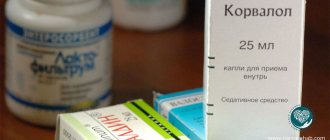The sixties of the last century were marked in pharmacology by the creation of a new drug. Clonidine saw the light. Initially, this medicine was positioned as an effective remedy against the common cold due to its ability to spasm small nasal capillaries.
But, literally immediately, doctors noted the powerful hypotensive property of the medication. Clonidine significantly lowered blood pressure, which turned out to be useful in the treatment of heart patients and hypertension. But why has clonidine for blood pressure, which was at the peak of its popularity in the 70-80s of the last century, now lost its former glory? What is this connected with?
Clonidine, used to treat hypertension, can be a deadly drug
Characteristics of the drug
Clophelin is a crystalline powder that is poorly soluble in ether, alcohol or chloroform, but excellent in ordinary water. The active substance is clonidine.
It is oxidized in the liver, 40–60% is eliminated from the body along with urine without undergoing changes, the remainder is destroyed in the liver tissues. When taken orally, it is absorbed into the blood almost 100%. The highest concentration is observed after 3–5 hours. When used intravenously, the effect occurs after 20 minutes.
Has the following effects:
- hypotensive;
- sedative;
- short-term vasoconstrictor;
- slight analgesic.
Available in tablets, as a ready-made injection solution in tubes with a dropper and in ampoules.
You can buy Clonidine only after presenting a prescription.
Indications
The drug is prescribed for the following problems:
- symptomatic hypertension caused by kidney disease;
- hypertension of undiagnosed nature;
- dysmenorrhea;
- open angle glaucoma.
If Clonidine is recommended, its interaction with other drugs must be taken into account. Otherwise, the risks of poisoning and side effects increase.
Contraindications
The use of clonidine is prohibited when the following conditions are diagnosed:
- hypersensitivity;
- hypotension;
- cerebral atherosclerosis;
- severe bradycardia;
- inflammation of the organs of vision;
- depression;
- cardiac shock;
- atrioventricular block 2 and 3 degrees;
- pregnancy.
You should not be treated with Clonidine during breastfeeding, since the active substance easily penetrates into milk and negatively affects the development of the child.
Prescribed with caution for diabetes mellitus, polyneuropathy, after a recent heart attack, in case of chronic heart, renal or liver failure.
Permissible dose of medication
Experts use Clonidine in various areas. It has a complex effect and is one of the most powerful drugs, so it is prescribed only when its safer analogues do not produce the desired effect on the human body.
The pharmaceutical industry offers a wide range of safe drugs to lower blood pressure, so Clonidine is currently rarely prescribed to people.
Usually it is used by doctors only in hospital settings. The effect of Clonidine on the human body can be unpredictable, especially if the drug is combined with other medications or alcohol is taken at the same time.
1. Acute hypertensive crisis. Clonidine will help if the patient’s blood pressure instantly rises to critical levels.
2. Arterial hypertension. In this case, substances such as clonidine, which is part of Clonidine, can also be added to the treatment regimen.
3. Withdrawal syndrome. Clonidine has a sedative effect, so it is sometimes prescribed to help a person recover from a long-term binge. Symptoms such as irritability and increased aggression disappear quite quickly.
If a person develops symptoms indicating a sharp increase in blood pressure, it is necessary to consult a specialist.
If the doctor deems it necessary, he will prescribe a drug based on clonidine, but it should be remembered that the combination of Clonidine with alcohol is detrimental to health and life-threatening.
The standard treatment regimen involves taking the drug orally, one tablet twice a day. In rare cases, if there are direct indications, tablets containing 0.15 mg of the active substance are taken four times a day. If the recommended dosage is exceeded, side effects may develop.
Symptoms of intoxication
In case of Clonidine poisoning, disorders of the nervous and cardiovascular systems are observed. The characteristic features are:
- dizziness;
- problems with spatial orientation and memory;
- weakness;
- decreased vision with normal reaction to light;
- hypotension;
- bradycardia:
- profuse sweating;
- dry mucous membranes;
- hypothermia;
- deterioration of peristalsis.
Normal mental activity, tendon reflexes and muscle tone are upset with minor intoxication.
Depending on the intensity of poisoning, damage by Clonidine is differentiated into 3 degrees:
- Easy. Consciousness is clear, dizziness, loss of coordination, and acidosis are present.
- Average. Accompanied by lethargy and drowsiness.
- Heavy. Muscular hypotonia is noted and coma is possible. Tendon reflexes are reduced.
If you combine Clonidine with alcohol, the symptoms intensify and the patient quickly falls asleep. In the preliminary phase he sees vivid hallucinations. Subsequently, this period of time is often erased from memory and is subject to amnesia. This influence plays into the hands of criminals who mix the drug into alcoholic drinks. Unfortunately, the permissible dosage is often violated, which leads to death.
Criminal clonidine
In police reports of the crazy 90s, one could often hear the expression “clonidine”. How did clonidine workers work, what is it? Criminal trade was more often carried out by female prostitutes with the aim of robbing clients. They quietly added the drug to alcohol.
Clonidine is also used by modern scammers
Clonidine and alcohol are a stunning mixture in the literal sense of the word. A person who tried such a drug passed out in a matter of minutes, completely lost orientation and fell soundly asleep .
Since none of the robbers was involved in calculating the safe dose, the victim had a high chance of not waking up at all. This mixture often led to serious poisoning and sometimes death of a person.
Clonidine was the favorite weapon of criminals due to the fact that it was completely impossible to recognize this substance in alcohol. Also, determine the content of the drug in the body during the autopsy of the deceased.
An alcohol-clonidine mixture in loading doses led to cardiac arrest, heart attack, cerebral hemorrhage and vascular rupture. This is why the unfortunate man died. Nowadays, due to the inaccessibility of the drug, clonidine has practically disappeared from the criminal world. But you can be poisoned by it, especially with an accidental overdose.
First aid
If one of your loved ones manages to be poisoned by Clonidine, the following measures must be taken:
- Rinse the stomach with water.
- Induce vomiting using a warm solution of table salt, pressing your fingers on the root of the victim’s tongue.
- Use activated charcoal as an antidote and Vaseline oil to cleanse the intestines.
- Call doctors who will provide first aid on the spot.
If Clonidine is not combined with alcohol or other medications, severe poisoning rarely leads to death. But for quality therapy it is necessary to transport the patient to the clinic.
Prevention
In order to prevent Clonidine poisoning, you must adhere to the following rules:
- do not use the drug without a doctor’s prescription;
- when using the medicine for therapeutic purposes, strictly adhere to the recommended dose and frequency of administration;
- Keep out of the reach of children;
- To prevent criminal poisoning, do not drink alcohol in the company of unfamiliar people.
Education: higher education, 2004 (State Educational Institution of Higher Professional Education “Kursk State Medical University”), specialty “General Medicine”, qualification “Doctor”. 2008-2012 – postgraduate student of the Department of Clinical Pharmacology, KSMU, Candidate of Medical Sciences (2013, specialty “pharmacology, clinical pharmacology”). 2014-2015 – professional retraining, specialty “Management in Education”, Federal State Budgetary Educational Institution of Higher Professional Education “KSU”.
The information is generalized and is provided for informational purposes. At the first signs of illness, consult a doctor. Self-medication is dangerous to health!
source
When is medical attention required?
Treatment of a patient with severe signs of poisoning is carried out in intensive care:
- If intoxication with Clonidine occurred less than 4 hours ago, the gastrointestinal tract is washed again using a probe.
- The remaining compounds are removed using forced diuresis.
- Tolazolin or Cerucal is used as an antidote.
- Stabilizes blood pressure.
- Perform continuous monitoring of cardiovascular activity.
- To create an optimal therapy program, water and electrolyte balance and central hemodynamics are examined.
- In case of convulsive syndrome, coma of 2-3 degrees, surgical detoxification or hemosorption is recommended.
Timely treatment helps reduce the risks of death, as well as the consequences of Clonidine poisoning.
For adults
The treatment regimen varies depending on the age of the patients. For example, the introduction of drug antagonists significantly increases the load on the heart muscle of a person over 60 years of age. Therefore, electrical stimulation is more often used to correct the rhythm.
On days 3–5, therapy is supplemented with a 10% glucose solution with a potassium-magnesium mixture, and Pentoxifylline is used to reduce the risk of acute psychosis.
For children
The nervous system of a small patient reacts very strongly to Clonidine. The following symptoms appear:
- convulsions;
- fainting;
- hallucinations;
- mental disorders;
- bluish skin;
- constriction of the pupils;
- breathing problems;
- oxygen starvation.
Blood pressure drops sharply and heart rate slows. Pinpoint hemorrhages appear on the surface of the body and mucous membranes as a result of damage to the pancreas.
At the first sign, call an ambulance immediately. The child suffers poisoning much more severely, and the risks of a tragic outcome increase.
Negative side effects of treatment
Not every patient responds normally to taking aggressive medications. The individual characteristics of the body must be taken into account by the specialist when prescribing the dosage of the drug.
In some cases, clonidine has side effects:
- Causes a sharp jump in blood pressure. As a rule, the effect is short-term and does not require medical intervention;
- Nausea, indigestion, dry mouth and decreased appetite;
- Sleep disturbance and depression, depression;
- In rare cases, it provokes confusion and hallucinations;
- Decreased libido, rarely – erectile dysfunction.
If you observe one or more symptoms, it is recommended to consult your doctor.
One of the factors that makes medication not recommended is withdrawal syndrome. Clonidine, when used for a long time, causes addiction to the body.
During the first two days after finishing the course of treatment, the following symptoms may be observed:
- Increased blood pressure that cannot be reduced with other drugs;
- Aching headaches;
- Dizziness;
- Stomach pain;
- Chills;
- Anxiety, supported by inexplicable fear;
- Increased salivation.
Discontinuation usually occurs in stages. The dosage reduction occurs over one or two weeks, replacing the medication with other antihypertensive drugs.
Possible consequences of overdose
Excessive amounts of Clonidine leads to serious complications:
- slow reaction;
- sudden change of mood;
- myocardial infarction;
- necrosis of areas of the brain;
- bradycardia;
- hypotension;
- allergy;
- swelling of the limbs.
The consequences do not necessarily appear immediately; sometimes months pass before the poisoning affects the body.
The drug of choice for hypertensive crisis is Clonidine: use in patients, why it is rarely prescribed
The drug reduces blood pressure due to its inhibitory effect on the vasomotor center of the brain. It is used for hypertension and symptomatic hypertension. Due to the pronounced sedative effect, it is now rarely prescribed, mainly to relieve a crisis.
Indications for use
Clonidine can be used for systematic use for hypertension, as well as secondary hypertension associated with kidney disease. Most often it is administered intravenously during a crisis of high blood pressure. In addition to these main indications, for complex therapy the drug is prescribed for:
- spinal anesthesia to enhance its effect;
- severe pain syndrome and resistance to Morphine (its analogues) in cancer patients;
- carrying out differential diagnosis of pheochromocytoma (does not reduce blood pressure if it is present);
- migraine to prevent headache attacks;
- dysmenorrhea with severe pain in the lower abdomen;
- increased blood pressure, hot flashes during menopause;
- drug withdrawal syndrome;
- alcohol and nicotine addiction;
- glaucoma (in drops);
- attention deficit disorder in children, hyperactivity.
We recommend reading the article about relieving a hypertensive crisis. From it you will learn about what a hypertensive crisis is, as well as the actions of an ambulance doctor and the treatment of a crisis.
And here is more information about the drug Anaprilin for arrhythmia.
At what pressure should you drink?
The drug is classified as an antihypertensive drug. It penetrates the blood-brain barrier to the cells of the vasomotor center and suppresses the flow of impulses aimed at narrowing the arteries.
Under its influence, the level of peripheral vascular resistance and the release of stress hormones decrease.
Due to its inhibitory effect on the brain, it has an analgesic and pronounced sedative effect.
When using Clonidine, systolic and diastolic blood pressure levels and pulse rate decrease. Long-term use reduces the load on the left ventricle and leads to the reverse development of myocardial hypertrophy.
The prescription of the drug for mild to moderate hypertension is justified; it is indicated for patients with an increase in values over 140/90 mm Hg. Art., but not exceeding 180/115 mm Hg. Art.
To reduce the availability of Clonidine, subject-quantitative accounting has been introduced for it in pharmacies. This means that to purchase you need a prescription stamped by a doctor and a clinic or hospital. After purchase, the prescription remains in the pharmacy and is stored for at least 3 years.
This precaution is associated with the use of the drug for criminal purposes. Due to the wide range of new effective antihypertensive medications, doctors rarely prescribe Clonidine to patients; it has remained the drug of choice for hypertensive crisis.
How to use Clonidine
For elderly patients, especially with manifestations of cerebral atherosclerosis, the initial dose of the drug is 0.5 tablets of 75 mg (a quarter of 150 mg); later, if well tolerated, it can be increased to the whole dose (75 or 150 mg). In the absence of conditions requiring caution when using Clonidine, it is prescribed from the first day in a single dose of 75 mg. The frequency of administration is usually 2 or 3 times a day.
If the target blood pressure is not achieved, the drug is combined with diuretics, Dopegyt, Raunatin or other antihypertensive drugs. The dosage should be increased gradually (0.5 tablets of 75 mg) every 2 days up to 2 - 3 tablets per dose. The pressure begins to decrease an hour after internal use and continues for 6 - 7 hours.
To treat hypertensive crisis, clonidine is used intravenously or intramuscularly. It is important that the injection does not exceed 0.15 mg, and the delivery of the drug into the vein is very slow. Rapid administration increases blood pressure by about 20 units, and in older people can lead to the development of a stroke or heart attack.
Recommendations
When using Clonidine as a course, you need to take into account the following features of its use:
- it is strictly contraindicated to combine with alcohol (a clonidine coma develops - the heart slows down, blood pressure drops sharply, consciousness is impaired, the patient falls into a long sleep, often with death);
- Blood pressure should be measured regularly, as clonidine's effectiveness decreases over time due to addiction;
- the inhibitory effect on the speed of motor and mental reactions is dangerous during work that requires speed of action.
It is strictly contraindicated to combine with alcohol, clonidine coma develops.
If you suddenly stop drinking Clonidine, a withdrawal syndrome occurs - a sudden increase in blood pressure, crisis, hand tremors, irritability, severe headache, nausea, vomiting. Therefore, if it is necessary to switch to another drug, first reduce the single dose by a quarter of a tablet, then after 2 days by the same amount, while simultaneously taking a new medication.
If withdrawal syndrome develops due to missing pills, you must return to Clonidine and gradually reduce the dosage. It is better not to prescribe this drug to patients with low adherence to treatment and memory disorders.
Cost of Clonidine
The drug is produced by many Russian and Ukrainian pharmaceutical factories. Its price category is quite affordable - a package of 50 tablets of 150 mg costs 22 hryvnia, 25 rubles, and 75 mg tablets cost 18 hryvnia, 23 rubles.
Ampoules of 10 pieces per package will cost 110 hryvnia or 29 rubles. Identical drugs in composition are produced by foreign manufacturers - Gemiton, Catapressan, Giposin.
Currently there is no registration for them, they are not available in the pharmacy chain.
We recommend reading the article about the use of the drug Liprazide. From it you will learn about the composition and properties of Liprazide, indications for use and dosage, as well as the cost and analogues of the drug.
And here is more information about the drug Methyldopa.
Clonidine is an antihypertensive drug with a central mechanism of action. It is prescribed to a limited extent in the treatment of arterial hypertension, mainly for emergency care during a hypertensive crisis. It has a number of shelf-life effects; if used irregularly, it can cause a negative reaction.
It is especially dangerous in cases of widespread atherosclerosis due to the threat of deterioration of cerebral and coronary circulation. Due to its analgesic and sedative effects, it is used in the complex treatment of pain and withdrawal syndromes.
Watch the video about which drugs should not be combined with alcohol:
Source: https://CardioBook.ru/klofelin-primenenie/
Non-standard methods of putting an alcoholic to sleep
Humanity has faced problems with forced immersion in sleep since the dawn of civilization.
Scientists offer 2 solutions to the problem
- pressing on certain points on the body;
- hypnosis.
Empirically, points on the body were identified that, when pressed, a person fell into sleep or unconsciousness. This skill can be useful for pacifying a drunken rowdy.
Where are the “sleepy spots” located?
You need to act on these points carefully, as there is a possibility of damaging the eyes, nose and other parts of the face. And the reaction of a drunk person can be unpredictable.
Hypnotherapy is an effective way to put a patient to sleep for a while. Hypnotic sleep is not a complete substitute for physiological sleep. At the same time, the connection with the patient is not lost. An experienced doctor should induce a state of hypnosis.
special instructions
In modern medical therapy, the drug “Clonidine” is practically not used. It is not used due to the characteristic sharp decrease in pressure. This effect is short-term. Subsequently, an increase in pressure is observed. We are talking about the Hemitonic crisis.
The drug is not recommended in case of withdrawal syndrome in patients with drug addiction. It is not prescribed for vasomotor disturbances due to dysmenorrhea and menopause. The use of the drug in acute myocardial infarction is undesirable. In such cases, it is better to use imidazoline receptor agonists.
In case of long-term use of Clonidine, it is necessary to monitor intraocular pressure.
The drug is able to enhance the effects of drugs that inhibit the functioning of the central nervous system, ethanol. Diuretics, vasodilators, and antihistamines enhance the effect of clonidine on the body. Tricyclic antidepressants, anorexigenic drugs, NSAIDs, sympathomimetics weaken the effect of the drug "Clonidine".
It is recommended not to use eye drops in combination with antidepressants and antipsychotics.
Prohibited methods of falling asleep
Various Internet forums are full of advice for wives of alcoholics. Some of them will really help, while others will harm.
Prohibited techniques:
- Scold, scream, make trouble. Your efforts will go to waste, since a drunk person is unable to adequately perceive criticism. In addition, it is unknown how an alcoholic will react to attempts at education. Wait until morning.
- Use sleeping pills without supervision and prescription from a doctor. Even those that you take personally and without health consequences. Paired with alcohol, this will give an unpredictable result.
- Do not repeat the actions of G. Vitsin from “The Adventures of Shurik”. Chloroform is not a toy, but an anesthetic.
- Don't hit your head with a frying pan. In addition to alcohol intoxication, a traumatic brain injury will be added. Then you should treat the sufferer.
If the degree of intoxication is low, then carry out home detoxification measures. Then give the brawler some milk or tea and put him to bed. If the person is inadequate, then call an ambulance and take the drunkard to the hospital. There they will take him out of his drinking bout, improve his health, and put him to bed.
Even in ancient times, doctors and other people practicing medicine tried to find a way to painlessly put a person to sleep. It is reliably known that even in the Stone Age, primitive people already performed complex surgical operations, and even amputation of limbs, but for many centuries, ancient surgeons and doctors were interested in the question: how to put a person to sleep?
Expert advice
Since from the above information it follows that mixing sleeping pills into alcohol is very dangerous for health, there must be other methods of calming a person:
- In order for a person to calm down, a drunk person must not be provoked into aggressive behavior. If he is already aggressive, then you need to try to stay away from him.
- A good way is to try to persuade a person to rest, to lie down.
- Sometimes the ignoring method works: the conversation is conducted in a calm voice, in lower tones. If a drunk is trying to tease, provoke, then you need to ignore such attempts.
Oddly enough, the best way to make a person fall asleep is to get him out of his state of alcoholic intoxication. To do this, you need to make him drink a glass of water in which 5 drops of ammonia are mixed or take activated charcoal.
The drug Clonidine, the effect of this drug on humans is well known. The drug has been used for more than a year in medicine and, unfortunately, in criminal activities.
In the 1960s, a new substance was synthesized - clonidine. Clonidine is available under different trade names, Clonidine being the best known. Belongs to a group of drugs with antihypertensive effects.
It was originally planned that the drug would become an effective treatment for the common cold. The active ingredient relieves vasospasm and makes breathing easier. Over time, clonidine was found to markedly lower blood pressure and induce sleep.
Fraudsters began to use this for criminal purposes. Why do clonidine specialists mix it into drinks and how long does it take for clonidine to start working?
First attempts to euthanize a person
The very first attempts to completely euthanize a person were made in Egypt and Syria. A person was put to sleep by squeezing the vessels of the neck; this method was used during circumcision operations. A method of disabling a person by bloodletting was also tested, which caused anemia of the brain. Sometimes such attempts ended very tragically and it was no longer possible to wake a person after such manipulations... It is logical to assume that the discovery of anesthesia belongs to one surgeon, or maybe even a group of surgeons, because it was surgeons who most faced the problem of putting a person to sleep and turning him off consciousness during surgery. However, it is not.
The first person to use anesthesia was the unknown doctor Thomas Morton. Dr. Morton was constantly in need of patients, as people were afraid of the pain that the dentist gave them during treatment, and therefore preferred to go with old and decayed teeth, just not to suffer. T. Morton was an ardent opponent of this situation and chose for his experiments the best anesthetic available at that time: diethyl ether. He approached experiments with ether very responsibly, conducted various experiments on animals, and after experiments on animals, he began to remove the teeth of his fellow dentists. Morton then constructed a very primitive apparatus for anesthetizing patients, and only when he was completely confident in his success did he decide to conduct a public demonstration of his anesthesia. On October 16, 1846, he called a surgeon he knew to remove a jaw tumor, and left himself the role of the world's first anesthesiologist. (Dr. Wells's previous demonstration of anesthesia was a fiasco due to poor choice of anesthetic and Wells's combination of two functions in one person: surgeon and anesthesiologist). The operation took place in deathly silence, and the patient slept peacefully. The doctors who gathered at the demonstration were amazed. The patient woke up to deafening applause from the audience.











